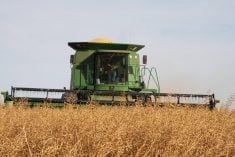A new public-private partnership in Saskatchewan will explore second generation biofuel and bioenergy production.
Canadian Green Fuels (CGF), the Saskatchewan Forest Centre and the University of Regina signed a memorandum of understanding July 10 to each contribute $50,000 annually for the next five years, either in cash or in kind, to fund research into new technology.
The first project, biomass gasification to produce clean fuel from wood fibre, will begin testing within weeks in Prince Albert, Sask.
Troy Metz, chief development officer for Regina biodiesel producer Canadian Green Fuels, said the partnership puts all three organizations’ research capacity to best use.
Read Also

Europe holds promise for Canadian lentils
Pulse Canada is trying to help boost lentil consumption in Europe, which is already the fourth largest market.
The idea is to “build infrastructure that helps the industry as a whole and not treat it as proprietary, kind of pockets of information,” he said.
The province’s biofuel sector has traditionally been touted as an agricultural saviour, offering new markets for grain and oilseeds.
CGF, for example, uses off-grade canola to produce its biodiesel.
Metz said the lack of an agricultural presence in the partnership shouldn’t be misconstrued. Biomass can certainly be agricultural waste, such as flax straw that is typically burned in the field.
CGF chief executive officer Mike Shenher called it an “evolution in feedstock.”
The forest centre’s involvement points to a new direction for that sector of the Saskatchewan economy.
Centre chair Sherry Michalyca sits on the executive at new generation co-operative Nipawin Biomass Ethanol. She said the Nipawin plant will use wood waste or flax straw to produce ethanol.
There is no shortage of forestry waste. A study done for the forestry centre in 2003 found more than six million cubic metres, or 2.5 million oven-dried tonnes, of existing stockpiled waste, including bark, sawdust and shavings.
“There’s piles of waste that are so old that they have developed their own ecosystems,” Michalyca said.
Tests have found “that 40-year-old sawdust has a higher BTU value than Estevan coal,” she added.
The 2003 study found BTU per pound of 5,340 to 8,930. Lignite coal from Estevan, Sask., has a value of about 7,000.
Metz said using a variety of sources to produce biofuel is a way to keep industries strong.
Michalyca said a cubic metre of wood turned into lumber earns $45.
“A cubic metre of wood made into 500 litres of biofuel is worth $500.”















